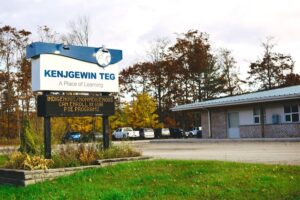Stable, long-term funding essential for equitable education access and economic growth in Indigenous communities

By Rick Garrick
M’CHIGEENG — The Indigenous Institutes Consortium (IIC), which represents Kenjgewin Teg and six other Indigenous-owned institutions, is calling on the federal government to address the chronic underfunding of Indigenous post-secondary education and fulfill reconciliation commitments.
“We’ve been advocating our message, I would say, for many years,” says Beverley Roy, president at Kenjgewin Teg. “But as political events, all of the things that happen regionally and nationally and even internationally, the urgency really is present right now. We’ve always been faced with inequitable funding and that has been our experience for many years. We really think we’re in a place to actually help and provide solutions to a lot of the things that are currently happening in education and training. The issue has always been present, but we’re really feeling it now in 2025.”
The IIC is calling for $93.6 million in federal funding and $78 million for urgent infrastructure renewals, student housing, and mental health support.
“The unmet demand for culturally grounded education is stifling opportunities for over 3,300 learners annually,” says Marsha Josephs, executive director at IIC. “Investing in Indigenous education isn’t just a constitutional obligation, but an economic necessity. With a 3:1 return on investment, graduates of Indigenous Institutes are filling critical labour gaps in trades, healthcare, and education.”
The IIC states that the Indigenous Institutes achieve graduation rates of 75 to 85 per cent, with more than 90 per cent of the graduates securing employment, but they receive significantly less funding than mainstream institutions.
“Ontario’s Indigenous population is growing four times faster than the rest of Canada, and over 75 per cent of our students are full-time learners,” Josephs says. “Without immediate investment, we risk missing a critical opportunity to strengthen Canada’s workforce and reconciliation efforts.”
Roy says Kenjgewin Teg offers certificate, diploma and degree programs in a range of areas such as teaching and learning; skilled, trades and apprenticeships; health and wellness; business and technology; and Anishinaabe studies.
“We’ve got teacher education, teacher degrees — we offer additional qualifications for teachers,” Roy says, noting they also have programs such as practical nursing and personal support worker. “There is a long list of programs with our partners, but we also do our own important work too in language. We’ve been doing several initiatives in terms of language promotion and language revitalization, and for us, these are the key things that really are important to us as well. Certainly we want to mobilize and contribute to the labour force development but it’s also about local community development at the First Nation level.”
Roy says their students come from everywhere, including First Nation students and non-Indigenous students from Manitoulin Island.
“We are growing more and more because we are the fastest growing population,” Roy says. “Through the introduction of virtual learning and use of technology and hybrid learning, where there’s a combination of in-person and independent learning, we are reaching more and more students pretty much everywhere so I would say the students come from all over Ontario right now.”
The IIC stresses that stable, long-term funding is essential for equitable education access and economic growth in Indigenous communities.
“We’ve been advocating for federal budget considerations for several years now,” Roy says. “As a sector, we’re no different than our college and university partners, just like they’re feeling the pressure, we’re feeling the pressure even more to provide the support and services that our communities and learners deserve.”


